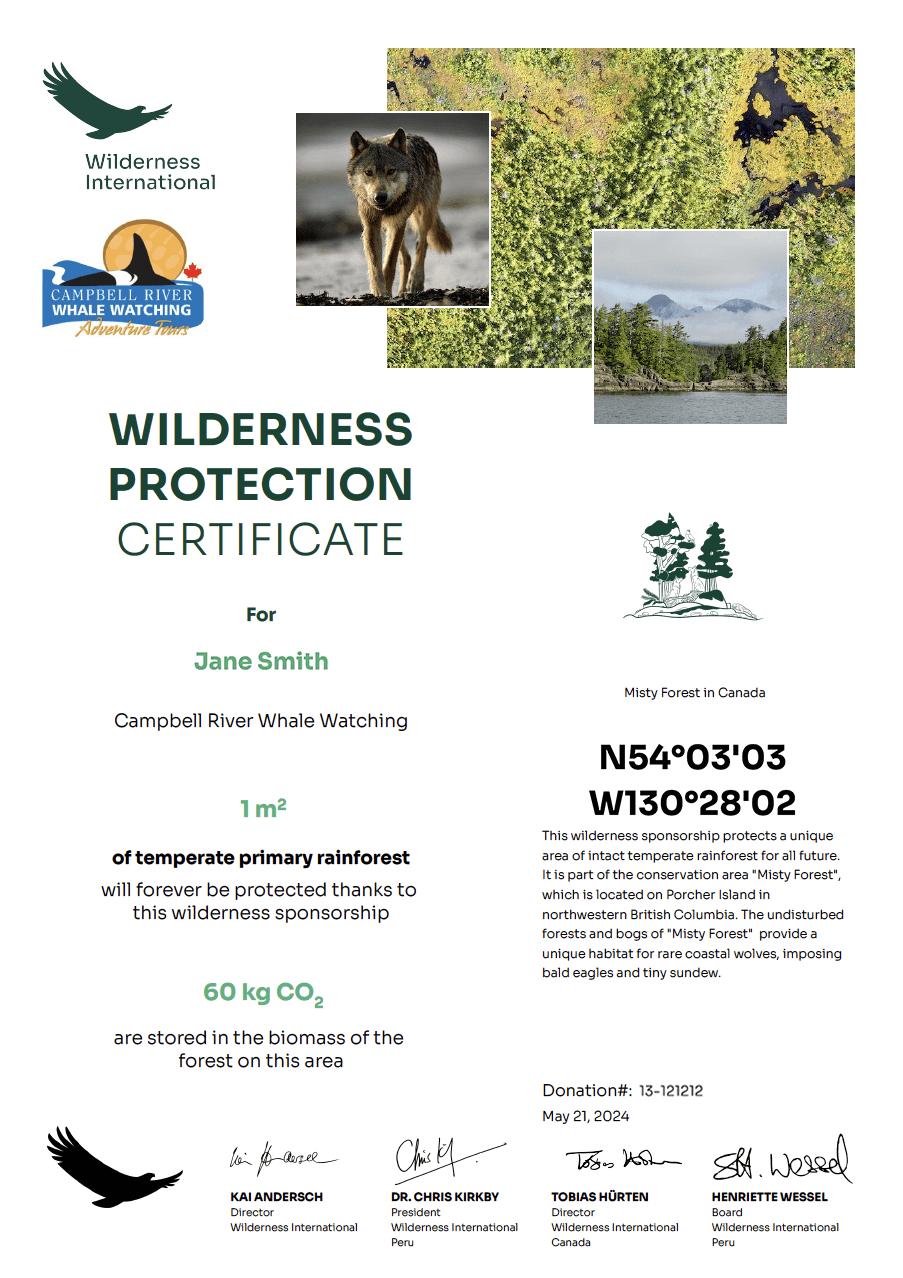Campbell River Whale Watching is committed to the protection of endangered wildlife
For the preservation of biodiversity & wilderness
Campbell River Whale Watching (CRWW) has been supporting the foundation with its expertise and logistics since Wilderness International began protecting and exploring Canada's Toba Valley in 2014. As a wildlife watching tour operator, CRWW thrives on spectacular natural landscapes and intact habitats. It was therefore an obvious choice to work with us to protect these wild habitats.
Let's continue on this path together and permanently preserve even more unique wilderness: Protect a piece of the Campbell River Whale Watching forest now.
Donations
have
m2 of old-growth forest
tonnes of CO2
remain permanently stored in the biomass of the forest

Campbell River Whale Watching and Adventure Tours is one of the leading providers of whale watching tours in the Vancouver Island region. Thanks to many years of experience, the company brings its customers closer to the fascinating natural world in new ways time and time again. As an active member of the North Island Marine Mammal Stewardship Association, Campbell River Whale Watching is committed to responsible whale watching.
The partnership with Wilderness International is incredibly important to us at Campbell River Whale Watching - it allows us to give back to the wilderness areas we depend on and protect the ecosystems our guests want to experience. Through this partnership, we can directly contribute to the preservation of pristine wilderness that is increasingly under threat.
Stephen Gabrysh
Owner of Campbell River Whale Watching and Adventure Tours
Impressions from the temperate rainforest
The wilderness areas that Campbell River Whale Watching protects in the temperate rainforest are located on Porcher Island on the west coast of Canada. They are the most species-rich ecosystem in the northern hemisphere. Their ancient giant trees provide a secure habitat for an incredible number of animal and plant species.

A view of the treetops in Canada's temperate rainforest.

The fluke (tail) of a humpback whale.

A rare coastal wolf on patrol on Porcher Island beach.

Resident orcas off Western Canada feed mainly on salmon.

A bald eagle hunting.

In the silence of the forest bog, the rare sundew catches flies with its sticky tentacles.
Transparency
Why old-growth forest protection with WI?
Campbell River Whale Watching was particularly impressed by Wilderness International's transparent and concrete use of donations: $1.50 donation protects 1 m2 old-growth forest - forever. Donors receive a certificate with the geo-coordinates and an aerial photo of the protected forest area, as well as a tax-deductible donation receipt.
You too can protect a piece of Campbell River whale watching forest
Let's continue on this path together and preserve even more unique wilderness in the long term:
Your wilderness protection certificate
You will receive a personalized certificate of the piece of wilderness you protected immediately after your donation.
Protect Wilderness with Campbell River Whale Watching Wilderness in Canada
About Wilderness International
The foundation, which is based in Peru, Canada and Germany, purchases legally secure wilderness areas and protects them for the future. The purchases are refinanced through donations, which ensure the long-term protection of the areas, supports environmental education projects, and research into CO2 storage and biodiversity.

Wilderness International purchases primary rainforest areas with land title and legally protects them for all future. Donations refinance the purchases and at the same time finance long-term protection as well as environmental education and research. Donors receive a personalized certificate with the exact geo-coordinates and aerial photograph of the forest area they are protecting. Thus, the use and impact of the donation is tangible and directly traceable. We are currently working in the temperate rainforest of Western Canada and the Amazon rainforest of Peru, where we are protecting ancient primary rainforests.
It is important to protect the rainforest because this is the only way we can stop species extinction and climate change. They are home to the world's greatest biodiversity and store huge amounts of CO2. It is also important to protect rainforests because they are the basis of our existence: they provide us with clean air, clean water and stable rainfall. They also cool the environment.
In Canada, good legal security helps us, as well as the legal situations and sanctions that even prohibit trespassing.
In Peru, we have additionally started a forest guardian program with local people. To ensure long-term protection, we also have several other measures in place. In general, we visit the areas on regular expeditions to check on them. We also work with local partners who inform us of any irregularities if necessary. The donations per square meter also already include the costs for property taxes.
Like no other, the legal form of the foundation allows a (charitable) purpose to be realized permanently and independently of outside interests, thus achieving the desired effects in the long term. It is thus the most long-term organizational construct currently known. Not even states, companies or national parks are designed for such a long term. This makes the foundation the only one that is oriented toward the lifespan of the ecosystems we protect.
